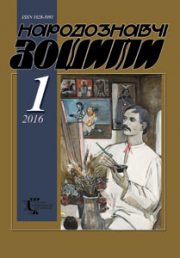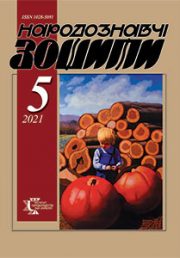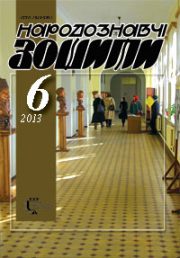The Ethnology Notebooks. 2024. № 3 (177), 571—583
UDK [94:639.1](477-18)”13/16″
DOI https://doi.org/10.15407/nz2024.03.571
HUNTING OF THE ABORIGINES OF THE NORTH LAND
BALUSHOK Vasyl
- ORCID ID: https://orcid.org/0000-0003-1362-8270
- PhD in History, Senior Research Fellow,
- Maksym Rylskyi Institute of Art Studies,
- Folklore Studies and Ethnology,
- National Academy of Sciences of Ukraine,
- 4, Hrushevskoho str., 01001, Kyiv, Ukraine,
- Contacts: e-mail: grigras@i.ua
Abstract. Introduction. Although the main branch of economy of the Sevryuks, the aborigines of the Siver region, was agriculture, hunting was one of their important occupations in the 14th—17th centuries. This was due to the richness of the hunting grounds of the region. Study Purpose: to investigate hunting among the Sevryuks.
Study Methods: the article is a study of historical anthropology and the history of everyday life, and the author belongs to the followers of the concept of the adaptive role of culture of neoevolutionists. Results. Feudal grants in the Seversky land included hunting grounds (beaver banks, beaver hony). In the feudal economy, special catchers (lovtsi) were known among dependent people, and Lovchi was organized by hunters. The Sevryuks paid tribute to fur, especially beaver fur. Beavers, martens, stoats, ferrets, squirrels, and otters were hunted for fur. For meat and skins, ungulates were hunted: moose, deer, roe deer, wild boars, bison, and bears. Wild horses — forest and steppe tarpans were caught for domestication, as well as for meat and skins, with the help of domestic horses. From birds, they hunted ducks, geese, cranes, swans, capercaillie, grouse, black grouse, sparrowhawks, and partridges. During the nesting season, eggs were collected from duck, goose, and swan nests. And chicks were taken from the nests of hawks, eagles and falcons to raise birds of prey.
Falconry was one of the favorite activities of princes and high-ranking officials, so falconry nests in feudal estates were registered. Hunting tools were: bows and arrows, spears, occasionally firearms, as well as hunting pits, traps (rozhen, pokolodva) and hunting nets (perevisy).
The cities were of different structures: specifically for catching birds, hares, and ungulates. Hunting dogs were also used.
Conclusion. Although the reconstructed picture of the hunting industry among the Sevryuks depicts its richness and extensiveness, it still needs further study.
Keywords: hunting, hunters, fur animals, ungulates, birds, traps, nets.
Received 10.05.2024
REFERENCES
- Rusyna, O.V. (1998). Siversk land as part of the Grand Duchy of Lithuania. Kyiv [in Ukrainian].
- Balushok, V. (2016). Mysterious sevryuks: 5. The name problem. The territory and the state of its population. Siveryan Chronicle, 6 (132), 44—55 [in Ukrainian].
- Kuczynski,S.M. (1936). Chernihiv-Sevier lands under Lithuanian rule. Warszawa [in Polish].
- Kotkova, N.S. (1963). Names of Russian Bort Marks a historical and linguistic source. Research on linguistic source studies. Moscow (Pp. 120—133) [in Russian].
- Anpilogov, G.N. (1964). Bort Marks as a historical source (According to the Putivl and Rylsky census materials of the late 16th and 20s of the 17th Century. Soviet Archeology, 4, 151—168 [in Russian].
- Bagnovskaya, N.M. (2002). Sevryuks: the population of the Seversk land in the XIV—XVI Centuries. Moscow [in Russian].
- Bagnovskaya, N.M. (2015). On the economic activities of the population of the Seversk land in the XIV—XVI Centuries. National Association of Scientists (NAS), IV (9), 6—9 [in Russian].
- Balushok, V. (2016). Mysterious sevryuks: 4. Ethnocultural features. Siveryan Chronicle, 4 (130), 3—15 [in Ukrainian].
- Balushok, V. (2017). Peculiarities of economic activity of the Sevryuks (XIV—XVII Сenturies). Folk Art and Ethnology, 4 (368), 41—50 [in Ukrainian].
- Balushok, V. (2020). Honey Hunting of the Sevryuks. Siveryan Chronicle, 1 (151), 5—15 [in Ukrainian].
- Balushok, V. (2017). Where did the Sevryuks go? Scientific works of Kamianets-Podilskyi National University named after Ivan Ohienko. Historical Sciences. To the birthday of Professor Valery Stepankov (Vol. 27,pp. 244—255). Kamianets-Podilskyi [in Ukrainian].
- Thomas, N., & Barnard, А. and Spencer, J. (Ed.). (2002). History and Anthropology. The Routledge Encyclopedia of Social and Cultural Anthropology: Second edition (Р. 343). London and New York: Routledge
- Krom, M.M. (2010). Historical anthropology. 3rd ed. corr. and additional. St. Petersburg [in Russian].
- Sahlins, M.D., & Manners, R.A., Kaplan, D. (Ed.). (2009). Evolution: specific and general. Anthropological Theory: A Sourcebook (Pp. 229—241). New Brunswick and London.
- Arutyunov, S.A. (1993). Adaptive significance of cultural polymorphism. Ethnographic review, 4, 41—56 [in Russian].
- Nikolaychik, F.D. (Ed.). (1900). Materials on the history of land ownership of the Vishnevetsky princes in Left Bank Ukraine. Readings in the Historical Society of Nestor the Chronicler (Book 14, pp. 84—192). Kyiv [in Russian].
- Massa, Isaac., & Liberman, A. (Ed.). (1997). Brief information about the beginning and origin of modern wars and unrest in Muscovy, which occurred before 1610 during the short reign of several sovereigns. About the beginning of wars and unrest in Muscovy (Pp. 13—150). Moscow [in Russian].
- Antonovich, V.B. (Ed.). (1886). Archive of Southwestern Russia (Part 7, vol. 1). Kyiv [in Russian].
- (1910). Lithuanian Metrics. Record book. I. Russian Historical Library, 27. St. Petersburg [in Russian].
- Ulashchik, N.N. (Ed.) (1975). Chronicle of Lithuania and Zhmoitskaya. Complete collection of Russian chronicles. Belarusian-Lithuanian Chronicles (Vol. 32, pp. 15—127). Moscow [in Russian, in Belarusian].
- Grigorovich, I. (Ed). (1846). Acts related to the history of Western Russia (Vol. 1). St. Petersburg [in Russian].
- Platonov, S.F. (Ed.). (1897). Complete collection of Russian chronicles. Chronicle collection, called the Patriarchal or Nikon Chronicle (Vol. 11). St. Petersburg [in Russian].
- Herberstein, Sigismund, & Anonimov, I. (1866). Notes about Muscovy. St. Petersburg [in Russian].
- Emelyanov, V. (1873). Travels of Guilbert de Lannoa to the eastern lands of Europe in 141—1414 and 1421. Kyiv University News, 8, 1—46 [in Russian].
- Mekhovsky, Matvey. (1936). Treatise on two Sarmatias. Moscow; Leningrad [in Russian].
- Gvanyni, Oleksandr, & Mytsyk, Yuri. (2007). Chronicle of European Sarmatia. Kyiv [in Ukrainian].
- Boplan, G.L., Kravets’, Ya.I., & Borysyk, Z.P. (1990). Description of Ukraine. Kyiv [in Ukrainian].
- Artyukh, L. (2005). Horse Meat in the system of food prohibitions of Ukrainians. Folk Art and Ethnography, 6, 24—29 [in Ukrainian].
- Balushok, V. (2018). From the history of Ukrainian ethnonyms (from «Rusyns» to «Ukrainians»). Ukrainian historical journal, 2 (539), 163—178 [in Ukrainian].
- Stоkl, G. (1953). The emergence of the Cossacks. Munchen [in German].
- Hehn, V. (1911). Cultivated Plants and domestic Animals in their transition from Asia to Greece and Italy as well as the rest of Europe: historical-linguistic sketches. Berlin [in German].
- Studer, Th. (1883). The wildlife in the pile dwellings of Lake Biel. Communications from the Natural Research Society in Bern from the year 1882, 1040—1056, 17—115 [in German].
- Lenz, H.O. (1856). Zoology of the ancient Greeks and Romans: German in excerpts from their writings, along with notes. Gotha [in German].
- Rudkovsky, A. (1882). About wild horses in the Kherson province. Kyiv antiquity, 11, 391—393 [in Russian].
- Grynchyshyn, D., Yedlinska, U., Polyuga, L., & Chikalo, M. (Ed.) (2001). Dictionary of the Ukrainian language of the 16th — first half of the 17th Centuries (Issue 8:D). Lviv [in Ukrainian].
- Pugolovok, Y.O., Gorbanenko, S.A., Sergeeva, M.S., & Yanish, E.Yu. (2015). Paleoecology of the surroundings of the Glyns’k archaeological complex of the 13th—14th Centuries. Archeology, 4, 109—128 [in Ukrainian].
- Shafonsky, A.F. (1851). Chernigov vicegerency, topographical description, with a brief geographical and historical description of Little Russia, from the parts of which this vicegerency is composed. Kyiv [in Russian].
- Levitsky, O. (Ed.). 1883. Archive of Southwestern Russia (Part 1, vol. 6). Kyiv [in Russian].
- Antonovich, V., & Melnik, K. (Ed.) (1890). Memoirs related to the history of Southern Rus’ (Issue I: XVI Century). Kyiv [in Russian].
- Husovsky, Mykola, & Sodomora, Andrii. (2007). A Song about a Bison. Poem. Rivne [in Ukrainian].
- Kirikov, S.V. (1983). Man and the Nature of the Steppe zone, end of the 10th— mid-19th Century: European part of the USSR. Moscow [in Russian].
- Sichynsky, V. (1946). Foreigners about Ukraine: a selection from descriptions of travels in Ukraine and other writings of foreigners about Ukraine over Ten Centuries. Augsburg [in Ukrainian].
- Timkovsky, I. (1874). Notes of Ilya Fedorovich Timkovsky. My definition of service. Kyiv and Moscow. Shuvalov. Russian archive, 6 (Vol. 1, pp. 1378—1465) [in Russian].
- (1903). Lithuanian Metrics: Book of Court Cases. Russian Historical Library, 20. St. Petersburg [in Russian].
- Ivanishev, N. (Ed.) (1859). Archive of Southwestern Russia (Part 1, vol. 1). Kyiv [in Russian].
- Sreznevsky, I.I. (1912). Materials for the Dictionary of the Ancient Russian Language based on written monuments (Vol. 3: R—Ya and additions). St. Petersburg [in Russian].
- Bilodid, I.K. (1977). Dictionary of the Ukrainian Language: in 11 vol. (Vol. 8). Kyiv [in Ukrainian].
- Kovalenko, Yu. (1993). Twelve months. People’s calendar. Kyiv [in Ukrainian].
- Sreznevsky, I.I. (1902). Materials for the Dictionary of the ancient Russian Language based on written monuments (Vol. 2: L—P). St. Petersburg [in Russian].
- Grynchyshyn, D.G., Humetska, L.L. & Kernytskyi, I.M. (2 eds.). (1978). Dictionary of the Old Ukrainian Language of the 14th—15th Centuries: in 2 vol. (Vol. 2). Kyiv [in Ukrainian].
- Dal, V. (1881). (1909). Explanatory Dictionary of the living Great Russian Language: in 4 vol. (Vol. 2: I—O). St. Petersburg [in Russian].
- Grinchenko, B. Dictionary of the Ukrainian Language (Vol. 3). Kyiv [in Ukrainian].
- Shukhevich, V. (1997). Hutsul’shchyna: reprint edition (Part 1—2). Verkhovyna [in Ukrainian].
- Sreznevsky, I.I. (1893). Materials for the Dictionary of the ancient Russian Language based on written monuments (Vol. 1: A—K). St. Petersburg [in Russian].
- Bilodid, I. K. (1973). Dictionary of the Ukrainian Language: in 11 vol. (Vol. 4). Kyiv [in Ukrainian].
- Pyrtey, P.S. (2001). Dictionary of Lemki speech: materials for the dictionary. Legnica; Wroclaw [in Ukrainian].
- Filin, F.P. (Ed.). (1979). Dictionary of Russian folk dialects (Issue 15).Leningrad [in Russian].
- Kostomarov, N. (1863). Acts relating to the history of Southern and Western Russia (Vol. 1, pp. 1361—1598). St. Petersburg [in Russian].
- Lototskyi, O. (1931). Ukrainian sources of church law. Warsaw [in Ukrainian].
- Semenov, A.V. (1854). Old Lithuanian Statute of 1529. Temporary journal of the Imperial Moscow Society of History and Russian Antiquities (Book 18, pp. 1—106). Moscow [in Russian].
- Belyaeva, S.O., & Kubyshev, A.I. (1995). Settlement of the Dnieper Left Bank of the 10th—15th Centuries (based on materials from settlements near the villages of Komarivka and Ozarychi). Kyiv [in Ukrainian].
- Karpov, G.F. (Ed.). (1895). Collection of the Imperial Russian Historical Society, 95. St. Petersburg [in Russian].
- Popov, N.A. (Ed.). (1890). Acts of the Moscow State, published by the Imperial Academy of Sciences (Vol. I: Razryadnyy prikaz. Moscow table, 1571—1634). St. Petersburg [in Russian].
- (1887). Handwritten notes by Peter Mogila. Archive of Southwestern Russia (Part 1, vol. 7, pp. 49—132). Kyiv [in Russian, іn old Ukrainian].
- Gloger, Z. (1902). Old Polish Illustrated Encyclopedia (Vol. III, p. 255). Warszawa [in Polish].
- Suprunenko, O.B., Pryimak, V.V., & Myronenko, K.M. (2004). Antiquities of the Golden Horde period of the Dnieper forest-steppe Left Bank. Kyiv; Poltava [in Ukrainian].







